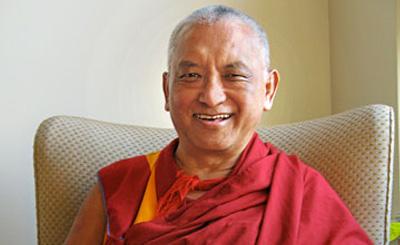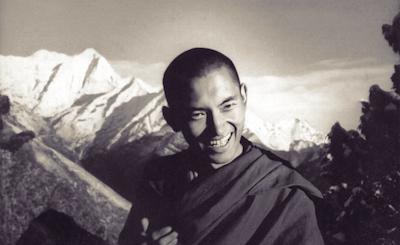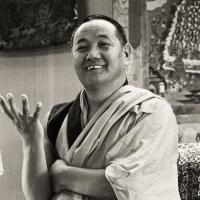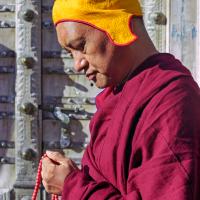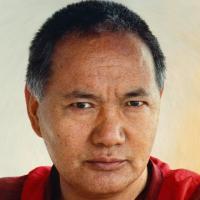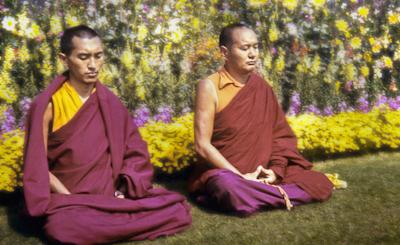For the benefit of all the kind mother sentient beings, I must achieve Avalokiteshvara’s enlightenment. Therefore, I am going to listen to the teachings on the Avalokiteshvara yoga.
Yesterday I didn’t finish explaining the meaning of the term Vajrayana. All the Mahayana teachings are included in the bodhisattva’s path of the six paramitas, which include method and wisdom. Again, both method and wisdom are contained in one method, bodhicitta. This is not the bodhicitta that we normally talk about. This bodhicitta actually means the transcendental wisdom of great bliss, Vajrasattva’s holy mind of concentration. Why is the transcendental wisdom of great bliss called bodhicitta? There might be other explanations, but one explanation that I heard is that it received the name of great compassion because it is out of the transcendental wisdom of great bliss, the dharmakaya, the buddhas manifest in the sambhogakaya and then the nirmanakaya, and then work for other sentient beings. The transcendental wisdom of great bliss is received from mahamudra, or great compassion. So, I think that’s why it is called bodhicitta.
Vajrasattva’s holy mind of concentration is the vajra and also the yana. There are two things, the interpretative meaning of vajra and the definitive meaning. The interpretative vajra is this one, and the definitive vajra, which is signified by the interpretative vajra, is Vajrasattva’s holy mind, which is also called Vajrasattva’s concentration. On the other hand, the meaning of vajra could be translated into English as “inseparable.” As I’ve already mentioned, the transcendental wisdom of great bliss has to be inseparable from something; two things have to be inseparable. I think I will just leave it there for now—maybe you can understand it some time in the future.
The purpose of using and keeping the interpretative vajra and bell together is also to remember the path that you have to practice and actualize, or the result that you are going to achieve. You keep the vajra to remind you that you are going to achieve the two things that are inseparable. Also, the bell signifies the wisdom of shunyata, so the bell signifies wisdom and the vajra signifies method. The definitive meaning of the bell is the wisdom realizing shunyata and the definitive meaning of the vajra is the transcendental wisdom of great bliss. While you are holding in your hands and using the interpretative vajra and bell, you are supposed to remember that they signify the wisdom realizing shunyata and the method, great bliss.
In order to achieve the vajra, Vajrasattva’s holy mind of concentration, Vajrasattva’s enlightened state, the transcendental wisdom of great bliss, which is dharmakaya, you must achieve the path of no more learning.
The unified state of no more training itself is the enlightened state of Vajrasattva, or Vajradhara. In order to achieve this state, you should achieve the unified path of training. In order to achieve the unified path of training, you should achieve the actual, or ultimate, clear light of meaning.
The Vajrasattva holy mind of concentration or the unified state of Vajradhara is the vajra, the transcendental wisdom of great bliss. This is Vajrasattva’s enlightenment, Vajradhara’s enlightenment, Avalokiteshvara’s enlightenment, Tara’s enlightenment, Guru Shakyamuni Buddha’s enlightenment, Manjushri’s enlightenment.
So, before you achieve this, you must achieve the unified path of training. Before this it is necessary to achieve the Vajrayana path of the actual clear light. In order to achieve this it is necessary first to achieve the illusory body. In order to achieve the illusory body, it is necessary first to achieve the gross and subtle graduated becoming. When you achieve the gross becoming, you can clearly see yourself in the manifestation of the deity and the whole mandala. There is no need to describe now the subtle graduated becoming.
The whole Vajrayana path is divided into the graduated path of becoming and the graduated path of fulfillment. The unified path of training and the illusory body are part of the graduated path of fulfillment.
In order to achieve them, you should first achieve the graduated path of becoming, gross and subtle. Before that, as a foundation for actualizing the graduated path of becoming, you should receive a perfect Highest Yoga Tantra initiation from a perfectly qualified vajra guru, one who is qualified to give initiations and reveal the Vajrayana teachings. After having received a perfect pure initiation from such a perfectly qualified Vajrayana guru, you should guard, or protect, the Vajrayana samayas, or pledges, as you protect your body or jewels from being stolen. Or as you protect your body from heat, cold, and other sufferings. Or as you protect your glasses from damage.
After having received a pure initiation from a perfectly qualified Vajrayana guru, you should fully protect, or guard, your Vajrayana pledges, or samayas. You should take care of these pledges more than your life. Then, before taking the Vajrayana ordination, you have to take the bodhisattva’s ordination, and also take care of the bodhisattva’s ordination more than your life.
As the necessary foundation before taking an initiation, you should train your mind in the general path, starting with meditation on the perfect human rebirth up to meditation on shunyata. However, the essence of the general path is to train your mind in the thought renouncing samsara, bodhicitta, and the wisdom realizing the right view. In order to achieve all these, you should train your mind in the general path. To do that, you have to perfectly follow the virtuous guide, who is the root of all perfections, of all good things. This means temporary perfections and happiness and ultimate perfection and happiness. The virtuous guide is the root of all your own Dharma knowledge. Perfectly following the virtuous guide, who is the root of the collections of all good things, has to be the preliminary practice. It is necessary to do this before you train your mind in and actualize the general path.
The whole path, the general path and the Vajrayana, the result of which is enlightenment, is completely based on the very first preliminary practice of perfectly following the virtuous guide. In order to perfectly follow the guru, you have to seek a guru who is qualified to show the Mahayana path.
This is just to give you a rough idea of the whole path from the very beginning up to enlightenment. This is just to give you a feeling of the steps of the general path and of even the Vajrayana path. In order to achieve the Vajrayana, you have to actualize all these paths.
I think I will now stop here. Maybe tomorrow, but probably after the retreat is finished, we’ll reach the Avalokiteshvara yoga meditation. Maybe you’ll hear about it while you’re flying back to the West. I’m just joking!
It is good to have some feeling for what vajra and Vajrayana mean. To talk in more detail, I myself am completely ignorant. I’m like an empty vase—no matter how much you beat an empty vase, nothing comes out. An empty vase doesn’t produce jewels. I am also scared to talk about Vajrayana teachings. You have to be wise and check skillfully. If you explain Vajrayana teachings, you have to check the minds of the listeners. If they are unreceptive beings, who are not fit vessels to listen to Vajrayana teachings, whose minds are not ripened, when you pour nectar, there is no way that vessel can keep the nectar. The nectar does not stay. If a teacher shows the teachings without checking to a listener who is not a vessel for the Vajrayana teachings, the teacher himself is in great danger of breaking the root vows of Vajrayana. There is a great danger that the teacher’s mind will be stained by a root fall of the Vajrayana. It is one of the root falls. By showing the Vajrayana teachings to a sentient being who is not a vessel for the Vajrayana teachings, one receives the root fall of revealing the secrecy.
[End of sixth teaching]







